

Let´s go diving! The pain of choice...
Bali offers some of the best Dive Sites in the world. There are not many places in the world able outperforming the huge variety of pelagics, nudibranchs, critters, hardcorals, softcorals and sponges. Here our Dive Sites.
If you want to go directly to a certain Dive Site, please just click on the name at the map.
Blue Lagoon Area
The Blue Lagoon which is in front of Padang Bai, is our house reef. There are 6 different sites, just a few minutes boat ride away from our Dive Centre and shop. Between the dives you will return to the Dive Centre and spend the surface break having coffee, tea, or just relaxing.
The Dive Sites of the Blue Lagoon are very diverse and hold new surprises for you (and us) every day! From beginner to professional divers, the Blue Lagoon offers great opportunities for all experience levels. Underwater photographers love the huge variety of species in the Blue Lagoon.
Besides moray eels, leaf scorpionfish, frogfish and plenty of nudibranchs you will find heaps of soft and hard corals. Frequently reefsharks and turtles hang out in this area. The Blue Lagoon is also our preferred night diving site! If you decide to complement your diving day with a nightdive, it is almost guaranteed to encounter a Spanish Dancer and a lot of the other nocturnal critters. With some luck you might even catch a glimpse of the rare coral cat shark.
• Shallow coastal reef (max 25m), slope, short wall
• Good variety of hard and soft corals, lots of feather stars, huge elephant corals and table corals
• Good number of oriental sweet lips, moray eels, turtles, lion fish, stone fish, octopus, cuttlefish, leaf scorpion fish and sharks (white or black tip, sometime nurse sharks)…
• Current: mild to moderate, good conditions for beginners
• Visibility: 25m+
Blue Lagoon - Temple
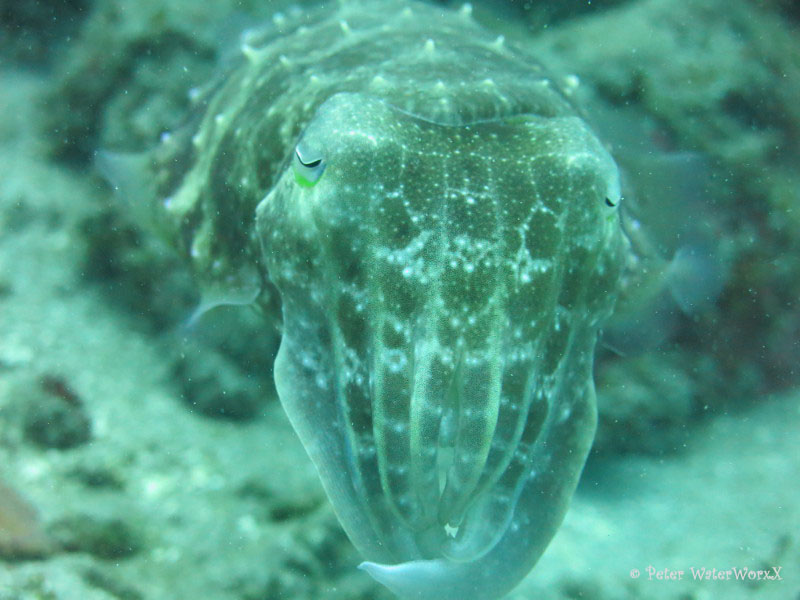
You start your dive in the shallows (5 to 9 metres) just in front of the small temple built into the lava cliffs. Well protected from the current, you dive along the reef edge where beautiful coral outcrops grow down along the sandy slope to a depth of 24 metres providing shelter to all kind of different reef fish. Cuttlefish can be seen here laying their eggs into the stack horn coral fields and you can observe sting rays digging in the sand for food. Flatheads, nudibranchs, flounders and stonefish are commonly encountered.
Blue Lagoon - Drop Off
To the northeast the Blue Lagoon is separated from the next bay (Jepun) by a rocky cape which continues under water as a vertical wall dropping off to a depth of 30 metres. The dive goes along the vertical wall into the next bay. The Drop-Off is home to hundreds of colorful featherstars, lionfish, scorpionfish, ribbon eels, sepias and a variety of shrimps that find shelter in the crevices inside the wall. With a bit of luck you find anglerfish, ghost pipe fish and the night active coral cat shark.
Blue Lagoon - Tanjung Sari
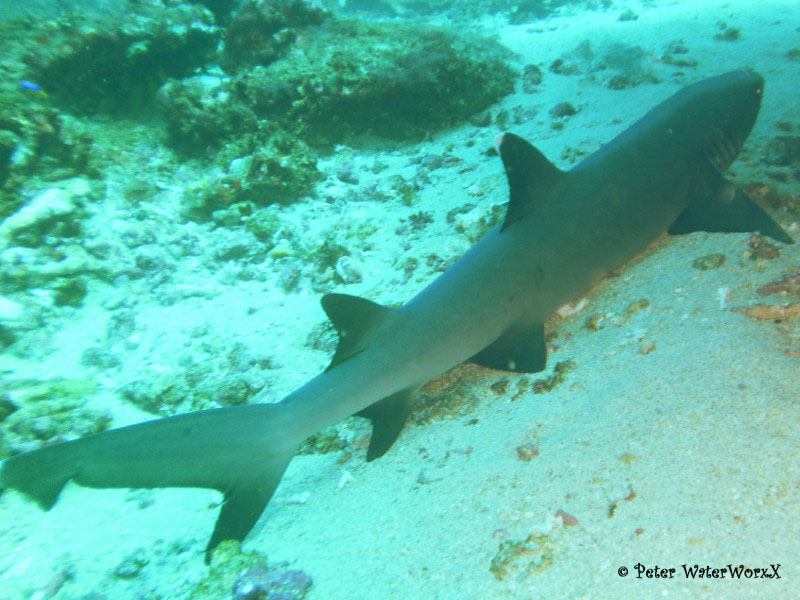
This Dive Site marks the southern end of the Blue Lagoon and stretches along the cape which separates the Blue Lagoon from the Padang Bai harbour. A protruding reef top featuring bizarre volcanic rock formations slopes gently down to about 30 metres where it ends in a sandy bottom.
Due to the location, this reef is more exposed to the current caused by tidal movement which in turn brings in a great number of schooling fish. Here you have a great chance of watching some reef sharks patrolling the area looking for food. Eagle rays, Napoleons and Tunas are regular visitors to this reef as well as the legendary Mola Mola (in season). The rock and coral formations of this reef also provides shelter for a lot more marine life such as to moray eel, lobster and octopus. Wobbegongs (carpet sharks) can be found here in the dry season (May to September) when the water is cooler.
After reaching the reef shallows, your return to the Blue Lagoon is made easier by diving through a labyrinth of rocky channels that protect you from any currents.
Blue Lagoon - Ferry Channel
The dive starts close to the green beacon which marks the starboard side of the narrow channel created for the ferries leaving for Lombok. After descending, you follow the slope in a southeasterly direction. A few minutes into the dive you will find several horizontal steps, some of which overhang to create shallow crevices where whitetip reef sharks rest. Smaller crevices are home to some big lobsters providing a great opportunity for U/W photographers to take some close ups. A couple of meters deeper and you find a nicely overgrown coral head featuring a cleaner station frequently visited by giant moray eels.
On our way along the slope a huge sea fan at 30 metres indicates that it is time to make your way to shallower water by heading east towards the Blue Lagoon. The chance to see pygmy seahorses and a great variety of nudibranchs are another highlight of this Dive Site. Turtles often hang out in the shallower parts of the reef towards the end of your dive.
Blue Lagoon - Bias Tugal
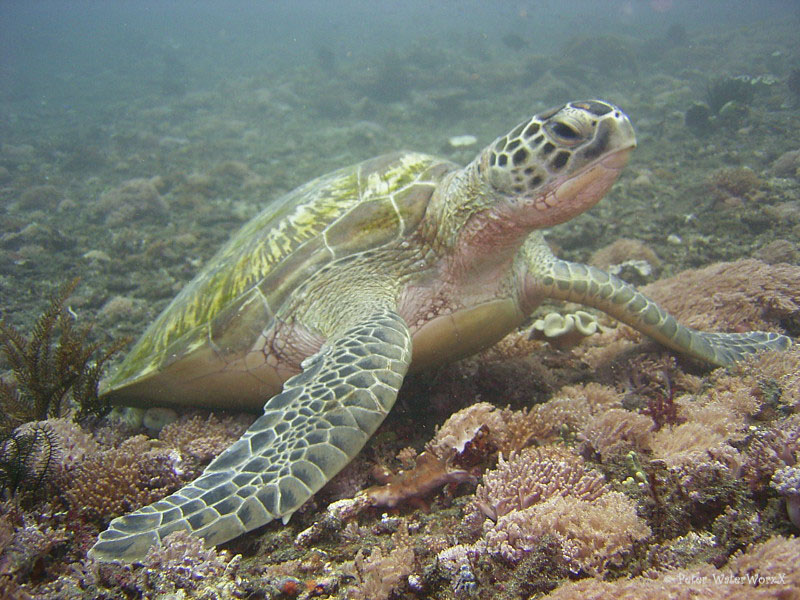
Bias Tugal is the name of the beautiful white sand beach on the east side of Padang Bai. The name means ‘Separated Sand’ in Balinese (Bias = sand, Tugal = cut, separation).
Explanation: The whole east coast features a volcanic black sand beach and just at this point the sand magically turns from black to pure white sand.
The entire bay consists of a flat bottom (9 metres) which is fully covered with soft coral and several boulders overgrown with hard coral. About 50 metres away from the beach, a 45 degree angle reef slope descends to infinity. On that slope you find a horizontal ledge at 20 metres. Heading along this ledge in southwesterly direction, it eventually merges into the slope. This is another good spot to find pygmy seahorses in the many sea fans scattering the area as well as big marble rays, lobsters, sharks and Mola Mola (in season). From there make your way back to shallower water and check out the top of the reef where there is a good chance of seeing turtles, nurse sharks, blue spotted sting rays and... many more species.
Blue Lagoon - Jepun
'We all live in a yellow submarine...'. Ok, the submarine is not yellow and we are not living in it. But seriously, on this Dive Site you can see a submarine, where non-divers are taken under water to admire Neptune´s realm without getting wet, but this is obviously not the highlight of your dive.
Jepun is located to the east of Padang Bai. After 15 minutes by boat sailing past the Blue Lagoon you will reach this Dive Site at the northeastern corner of Amuk Bay. The area provides good opportunities for all experience levels. An artificial reef includes a small shipwreck and some meditating Buddha statues offer a change of scenery.
Begin the dive in the shallow sandy area, dive along the rubble slope until you find the ship wreck at 18 meters. This wreck, which was sunk on purpose in 2008 as an artificial reef structure is now nicely overgrown. Some big moray eels made it their home and a large swarm of cat fish can be found below the deck. Large sting rays often rest under the hull.
From there you will be able to see the rebar wire structure along which you continue the dive heading south. Around the Buddha statues in 10 metres you can find mantis shrimp and a lot of other rare crustaceans, even harlequin shrimp (if you get lucky). Ghost Pipefish, dragonet, flying gurnard, frogfish, sea moth (Pegasus) and the thorny sea horse are some of the species you may encounter.
Jetty - Tanah Ampo - let´s go Muck Diving!
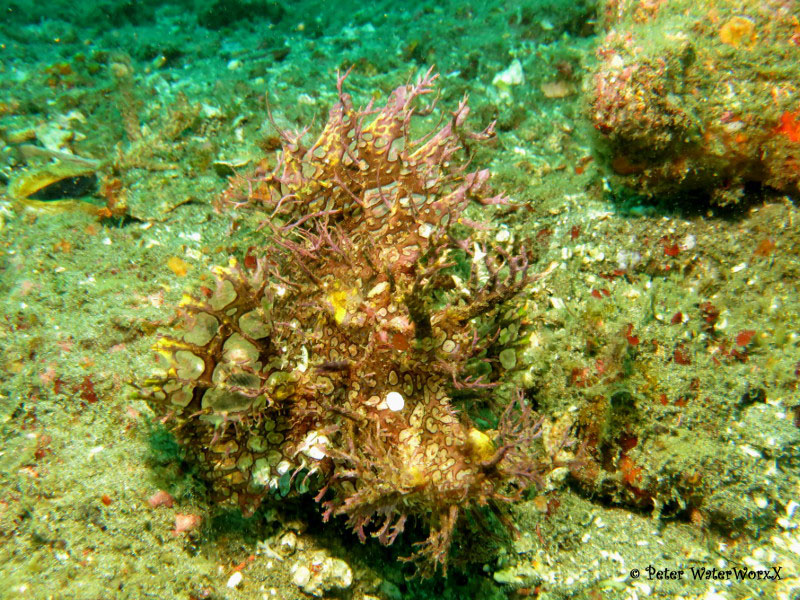
This Dive Site is a highlight for all underwater photographers! The Jetty is the pier in front of the small village Tanah Ampo. It is located 20 minutes to the east from Padang Bai right in the center of Amuk Bay. This pier was initially built as a landing facility for luxury cruise ships visiting Bali. Most likely some government officials did not do enough research when planning the facility because nothing worked out as it should have. Therefore, after spending millions of taxpayers’ money they decided to abandon this project. These days it’s used by recreational fishermen and us happy divers.
The Jetty offers an unbelievable variety of creatures in just one dive! Nudibranchs in all colours and sizes, different kinds of anglerfish, flying gurnards, ghost pipefish, ribbon eels, mimic and blue ring octopus, variety scorpionfish (Rhinopias!), cuttlefish just to mention some.
The dive route leads you around the pillars in depth ranging from 10 to 18 metres. Due to the sandy bottom composition all animals will look to the pillars for shelter which makes spotting them easier. It offers photographers the rare opportunity to get excellent and clutter free pictures from these normally extreme well camouflaged species! Often schooling mackerels circumnavigate the pillars and make the scenery below the pier unforgettable, even without a camera.
• Sandy ground , stelae of the pier covered with beautiful soft corals and small gorgonians in all colors
• Nudibranchs of all sizes and colors, frog fish, gurnard, ribbon eels, mimic octopus, blue ring octopus, cuttlefish, scorpionfish and last but not least: Rhinopias!
• Current: usually none, but if there is... uncomfortable!
• Visibility: 10 – 15 metres
• Macro Heaven!
Gili Tepekong / Gili Mimpang
Gili Tepekong
This rocky island is located in Amuk Bay about 1,5 Kilometer southeast of Candi Dasa. After a 20 minutes boat trip from Padang Bai, you will be ready for another unforgettable dive experience!
Tepekong West (The Canyon and infamous 'toilet')
You enter the water on the western flank of the island, follow the vertical wall south until you find a narrow rocky rim (some people call it canyon) at around 27m heading west. Follow this rim and it will lead you to the two underwater pinnacles. If the current is stronger, drop behind this rim (30m) to find shelter during the approach to the pinnacles. However, if the current is to strong pushing direction south things can turn hairy and you might end up in the 'toilet' located approximately another 50 metres south of the rim, where the down currents can cause the dive to be aborted...who likes to get flushed?
The pinnacles are fully overgrown with hard coral, sponges and fans. There is a high density of reef fish, often sharks, schooling tunas, eagle ray, java ray and Mola Mola in season.
Tepekong East (Swim through)
The dive begins close to the cliffs on the east side of Tepekong, just under the little light house. You dive along a shallow wall southwards, until you see the “swim through” entrance at 18 metres. On entering, you will be able to see the exit which is at 26 metres. It is a 15 metres swim through that takes you to a breathtaking vertical wall dropping off to over 65 metres. From there you turn towards the east and make your way back along a sloping reef featuring several coral outcrops surrounded by vibrant marine life.
At the northeastern tip of Tepekong, you find a shallow sloping reef featuring several huge submerged rock boulders under which you can find young reef sharks which offers a good opportunity for close up pictures of these guys. Furthermore, you can see, turtles, different kinds of scorpion fish, frog fish and pygmy seahorse just to mention a few.
Due to possible strong currents at full/dark moon and greater depth, this Dive Site is only for experienced diver.
• Excellent growth with hard and soft corals
• Whitetip reef sharks, turtles, rays, schools of barracuda and tuna, in the season from July to October chance of stunning ocean sunfish - Mola Mola!
• Current: Mild to very strong! Full and new moon very strong!
• Visibility: 25 metres +
Gili Mimpang (Shark point, Shark junction)
The three tiny cliff islands half way between Candi Dasa and Tepekong are reached in just 25 minutes by boat from Padang Bai.
The dive starts on the Bali facing side of the middle cliff harbouring the only tree for miles around. Over a rubble slope (12m) diving southwest towards the most western cliff island until you find a 45 degree angled coral slope and you have reached shark junction, a very good spot to see sharks patrolling the reef, swimming at the same level as you and if lucky even above you. In this area you will have a high chance to see Mola Mola in the dry season because we notice that on this point the Molas like to come to get their skin cleaned by a whole armada of banner fish! From there you follow along the slope until the angle of the reef turns vertical. On this corner follow along the steep wall into an easterly direction all the way until you reach the shallow slope behind the cliffs, where massive schools of fish like to hang out.
Due to possible strong currents at full/dark moon and greater depth this Dive Site is only for experienced diver.
• Excellent growth with hard and soft corals and sponges
• Very large variety of tropical fish, sharks, big rays and occasionally from May to November is a good chance to see Mola-Mola ...
• Current: Mild to very strong! Full and new moon very strong!
• Visibility: 25 metres +
Gili Biaha (Shark cave)
Gili Biaha is located at the eastern end of Amuk Bay and reached in 30 minutes by boat. This small rock island has a U shape with the open side facing the open ocean.
The boat will drop you of right in the center of this U. On your way down you will notice the beautiful cliff terraces fully overgrown with different kinds of hard and soft corals, fans, and sponges leveling out at around 40 metres into the sea floor. At 12 metres you will find the entrance to the Shark Cave. The inlet is a comfortable 5 by 5 metres hole, which reaches back 18 metres in to Gili Biaha and then opens into a domed cavers. Whitetip reefsharks like to hide out there resting during the day. Crevices in the cave walls give shelter to big rock lobsters and hundreds of other critters. An unforgettable moment will be the point when you turn back and look into the blue water at the mouth of the cave swirling with swarms of countless fishes illuminated by Bali’s tropical sun!
The eastern and western corners of Gili Biaha are more exposed to currents, with a high chance to see pelagic species approaching from the open ocean. Mola Mola can be seen here during the dry season.
Due to possible strong currents at full/dark moon and greater depth this Dive Site is only for experienced diver. It is not possible to dive here on days with big ocean swell.
• Excellent growth with hard and soft corals and sponges
• Very large variety of tropical fish, sharks, big rays and occasionally from May to November is a good chance to see Mola Mola ...
• Current: Mild to very strong! Full and new moon very strong!
• Visibility: 25 metres +
Gili Selang
This small islet, located just a few meters away from the mainland, is Bali’s most eastern point. After a one hour ride, the boat will drop you off inside the bay on the north side of the island. The beautiful gently sloping reef inside this bay is fully covered with hard and soft coral. Plenty of colorful reef fish inhabit the area. If the current is not too strong, dive along the edge of the island were the slope turns into a vertical wall. After passing the protruding cape of the island were currents can be fairly strong, you will find shelter in the shallow cove located on the south side of Gili Selang. Before you finish the dive, it’s worth looking under the coral boulders where reef sharks often rest.
Due to the remote location of this dive site, only few operators will take their guest there, expect a untouched reef and no other divers.
Ocean conditions can change from very calm to very rough with tons of current in an instant, therefore suitable for the experienced diver only.
• Laguna and Drop Off colorful growth of hard and soft corals
• Large number of tropical fish! Due to the flow conditions good chance to see some big ones...
• Current: mild up to very strong!
• Visibility: 25 metres ++
Nusa Penida North - Toyapakeh, S.D., Ped, Sental, Buyuk, Kutapang
Nusa Penida is Bali´s neighbouring island located 13km south of Padang Bai separated from Bali by the ‘Badung Strait’. The interior of Nusa Penida is hilly with a maximum altitude of around 500 metres. Unlike the small island of Nusa Lembongan, located west of Penida, there is very little tourist infrastructure here. Life is quite hard for local folk, and agricultural opportunities are limited since this island is much drier then Bali.
Nusa Penida North is well known for its crystal clear water and an amazing visibility! Due to the strong tidal current flowing through the Badung Strait, dives on the north coast of the island most likely will be accomplished as drift dives.
The boat will drop you off about 30 meters away from the shore at the point where the 45 degree coral slope just starts in 10 meters of water. Find your target depth on the slope and just let the current take you on a ride. Drift past amazing and perfect intact coral reefs, huge barrel sponges, whip coral and an abundance of colorful reef fish. Towards the end of the dive make your way up to the shallow reef top for your safety stop. The current gets less intense closer to the shore.
Even if the current is strong these sites can be dived by the experienced diver almost at any time, the reefs are kilometers long and the current runs parallel to the shore.
We have discovered a couple of spots on Penidas north coast where the current splits. At these points, during the dry season, you have a high chance to see Mola Mola coming to the shallower waters to get their skin cleaned by banner fish.
• Excellent growth with hard and soft corals and sponges
• Greatest number and variety of tropical fish around Bali, frequent encounters with pelagics like Tuna, Manta Ray, Mola Mola and sharks (whitetip reef sharks)
• Current: mild up to strong! Drift dives
• Visibility: 25 up to 50 metres, best visibility in Bali even during the raining season march until November
• The Dive Sites Nusa Penida North are suitable for the intermediate to experienced diver
Crystal Bay - Nusa Penida
Crystal Bay got the name because of its crystal clear waters. On top of the outstanding visibility, the colorful coral reef within this bay is considered to be one of the healthiest and richest reefs in the world.
This bay is located on the Penida side of the narrow channel separating Nusa Penida from Ceningan. The shallow bay features a beautiful white sand beach and a little rock island in its center that protrudes into the channel. You start your dive on the south side of this island and dive along its rocky edge until you reach a drop-off. At this point, you are in the channel itself and the slope has changed into a vertical wall. This is where you have a very high chance to see Mola Mola in season. From there you make your way back the way you came, but through the shallower part of the reef.
If you hear the word diving and channel in one sentence one has to pay extra attention! If people dare to jump in the water when currents are strong or are running in the wrong direction then this dive can be very dangerous. Our divemasters and boat captains know this site like the back of their hands and only enter the water if conditions are safe enough. This Dive Site is for the experienced diver only.
As far as the eye can see: hard- and softcorals, sponges, gorgonians. Fabulous! There is almost nothing that you cannot see here! Schooling fish in the blue, rays, sharks, turtles, snakes and during a season very high chance for Mola Mola!
• Hard- and softcorals, sponges, gorgonians
• Schooling fish in the blue, rays, sharks, turtles, snakes, during the season very high chance for Mola Mola!
• Current: mild up to very strong! Conditions have to be clearly checked before the dive!
• Visibility: 10 – 50 metres!
Nusa Lembongan - Crystal, Mangrove, Blue Corner
Nusa Lembongan is the little island next to Nusa Penida to the west. Lembongan has developed over the last 10 years into a fancy resort island with a well-organized tourist infrastructure.
Dive Sites are similar to the Dive Sites of Nusa Penida North. You will notice that the reef top stretches further out before the slope begins. Like Nusa Penida, due to strong tidal current flowing through the Badung Strait, the dives will be accomplished as drift dives.
At Crystal and Mangrove the reef is long enough for a fast drift dive but Blue Corner can be a bit trickier as, with a strong current, it is possible to overshoot the end of the reef. This would mean ending the dive in blue water far away from the safe shore.
• Excellent growth with hard and soft corals and sponges
• Greatest number and variety of tropical fish around Bali, frequent encounters with pelagen like Tuna, Manta Ray, Mola Mola and sharks (whitetip reef sharks)
• Current: mild up to strong! Drift dives
• Visibility: 25 up to 50 metres!
Manta Point / Manta Bay - Nusa Penida
Even the journey to this legendary Bali Diving Site is an experience one doesn't easily forget. You leave Bali in the morning mist, to travel south on the dive boat through the channel that separates Nusa Penida from Nusa Lembongan / Ceningan. Inside the channel which also has some superb diving if currents allow, one can make out scenic little tranquil bays with picturesque white beaches. While Bali disappears at the horizon behind us the spectacular cliffs of the south coast of Nusa Penida lies ahead at the exit of the channel. Here we have to make the decision whether the diving conditions for Manta Point are suitable.
Now we're heading for the open Indian Ocean which, with its sometimes gigantic waves sculpts the sheer cliffs of Nusa Penida's South coast. Along the way we are pass bizarre rock formations and little rocky islands standing in the tremendous currents, waterfalls cascading down from the heights of the cliffs towards the ocean. After approximately 1 hour we arrive at Manta Point.
The actual Dive Site lies well protected from currents by a rocky cape. Often you will already be able to see the giant Manta Rays from the surface. Huge rock formations create a bizarre under water landscape that slopes gently down to unfathomable depths.
During the dive you just hang out around the giant rocks which are home to an army of cleaner fishes. The Manta Rays cruise around the rocks, some just hovering above the cleaner stations and enjoying the treatment they receive. Without doubt this is the reason why this gentle giants come here.
Even snorkelers get a good view of the Manta Rays since most of the action here happens in fairly shallow water. And those who don't dare to go in the water can witness the spectacle from the boat.
• Lush vegetation of leather corals and sponges
• Nursesharks, millions of cleaner fish, nudibranchs, stingrays and... of course the majestic Manta, Manta, Manta Rays!
• Current: none – mild. Waves!
• Visibility: 10 – 20 metres
Jemeluk / Amed
The Dive Sites of Amed are located around the Jemeluk Bay on Bali’s north east coast. It is an 80 minute car drive away from Padang Bai. After assembling your gear on the shore, traditional outriggers (Jukung) will sail you to the dive locations within a couple of minutes.
Eel Garden – Artificial Reef / Drop-Off
The dive starts on a shallow sand plateau were hundreds of garden eel are sticking their heads out of the ground. Dive parallel to the shore heading east, you come along a coral slope which levels at around 18 meters into the sandy sea floor. Interesting pyramid shaped artificial reef structures line the path of your dive till you reach a spectacular Drop-Off. The vertical, thoroughly covered color full coral wall flattens out 200 meters marking the end of this dive.
Coral Garden - Drop Off´s
The eastern side of the bay features a beautiful shallow coral garden, very popular for snorkeling. About 30m away from the shore you will find several underwater cliffs, with vertical walls towering from the depths of the ocean all the way to the edge of the coral garden.
Jemeluk’s Dive Sites are very color full with an abundant marine life, very good visibility, and usually calm conditions, very good spot for macro photography (pygmy seahorse, ghostpipefish ect.). Suitable for all experience levels.
• Steep faces with beautiful vegetation of hard and soft corals
• Large number of tropical fish: triggerfish, parrotfish (including the buffalo head parrotfish), moray eels, reef sharks, turtles...
• Current: none - mild
• Visibility: 25 metres +
Kubu Reef
Kubu is the name of the village located a few kilometers west of Tulamben. At first a shallow reef stretches out 30 meters from the shore then turns into a gentle slope which ends at 24 metres with a little rocky step leveling out into the sandy ocean floor. In the shallows large stack horn coral fields can be seen and big table corals dominate the underwater landscape. On the slope you will find big barrel sponges where large numbers of lionfish hang out and several sea fans have the potential to host pygmy seahorses.
After the beach entry begin your dive over the sand until you find the edge of the reef. Follow the edge until you pass the step at the deep end of the reef, after which you zigzag your way back up to the entry point. Easy, calm conditions, suitable for all experience levels.
• Excellent growth of hard and soft coral
• Large number of reef fish, crabs, nudibranchs and the chance of pygmy seahorses!
• Current: none - mild
• Visibility: 10 – 25 metres
Tulamben - Wreck U.S.A.T. Liberty / Drop Off
The U.S.A.T. LIBERTY is a 120 metres long shipwreck, the remains of a US World War II freighter, which was torpedoed on 11th January 1942 at 4:15 am. by a Japanese submarine. The ship has been crossing the Lombok Strait carrying material (rubber and railway parts) from Australia to the Philippines. Two US destroyers hitched up to the ship and tried to tow it to the port of Singaraja. The damage was immense, she was taking in too much water and her crew ran the vessel up onto the beach of Tulamben 70km away from the nearest safe harbor.
For 21 years she stayed there, the people of Tulamben secured all items of any value, even parts of the deck. In 1963 the Liberty was pushed to her present location by the fatal eruption of the volcano Gunung Agung. During this process the hull broke into two pieces. Now she is laying only 30 metres from the Tulamben beach on a sandy slope, at a 90° angle on her side, parallel to the shore. The deck side faces the ocean.
The Liberty ship wreck is the most visited Dive Site of Bali, and it is at the perfect depth for scuba diving ranging from 3 metres down to 29 metres. There are a couple of impressive swim throughs, but care must be taken as the structure of the wreck is unstable with parts collapsing every year. An amazing growth of encrusting animals cover the wreck, marine biologists estimate that about 400 different species of reef fish live on the Liberty.
• Excellent growth with hard and soft corals and sponges
• Around 400 species of reef fish live on the liberty! Surgeonfish and bumphead parrotfish welcome you at the wreck, barracudas, napoleons and turtles hang around...sharks can be seen aswell as small creatures like the tiny pygmy seahorse!
• Current: none - mild
• Visibility: 10 up to 25 metres
Menjangan
Pulau Menjangan is part of the national park and situated in the most northwestern part of Bali. It takes several hours by car from Padang Bai to reach this island, therefore we offer excursions to Menjangan only during Diving Safaris, where we spend the night in Permuteran or Lovina located closer by.
Menjagan is known for its spectacular reefs and steep walls with great visibility ranging often up to 50 metres! The vertical walls begin in the 10 metre range, dropping off at times to 60 metres. The slopes are very colorful, scattered with crevices, cracks and gaps full of marine life. One highlight is the Dive Site 'Eel Garden' were there are thousands of garden eels live in a sandy depression between two reefs, as far as your eye can see eels, eels, eels...
Often sharks patrol the area, eagle ray, turtles and schools of bat fish can be encountered, nevertheless it’s an excellent site for macro diving as well (pygmy seahorse, ghost pipe fish etc..). Menjangan has the greatest diversity of gorgonian fans in Bali.
• Excellent growth of hard and soft corals, sponges and amazing sea fans!
• Large number of reef fish, nudibranchs but as well turtles, sharks and rays!
• Current: none - mild
• Visibility: 25 metres ++
Pura Jati
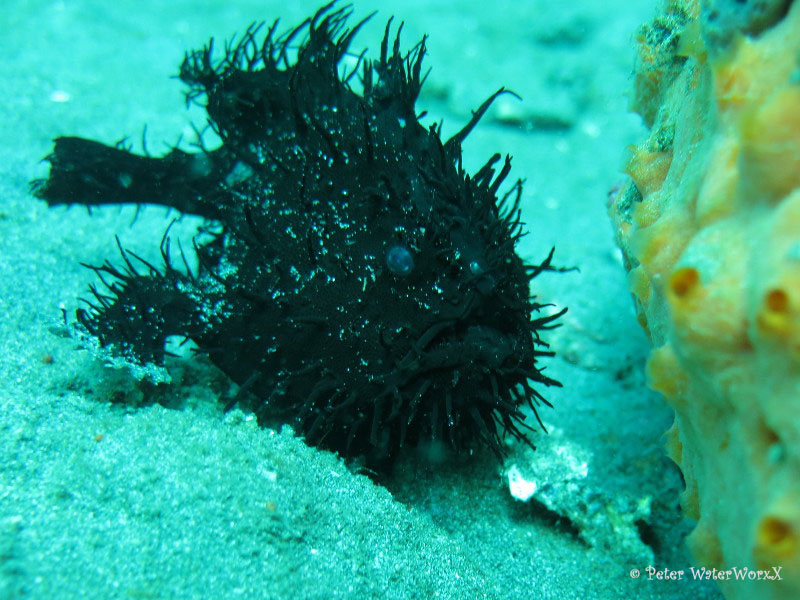
Pura Jati is a relatively unknown diving spot on Bali's north coast near Lovina. Due to the very long car ride from Padang Bai, we combine this Dive Site only in a Diving Safari before or after diving in Menjangan.
Pura Jati is a paradise for macro fans! A large reef plateau starts in two metres of water and runs gently down to 20 metres. Entry is from the black sand beach, which continue under water and is covered by seagrass. The plateau is home to countless microorganisms such as ribbon eels, leaf fish, ghost pipefish, nudibranchs, seahorses, shrimp, crabs, mimic octopus and the tiny Clown frog fish and frog fish.
• Black sandy soil traversed by sea grass with scattered coral structure
• Countless microorganisms such as ribbon eels, leaf fish, bat fish, ghost pipefish, nudibranchs, seahorses, shrimp, crabs, mimic octopus and the tiny Clown frog fish and frog fish. Perfect for U/W photographers
• Current: non - mild
• Visibility: 10 metres
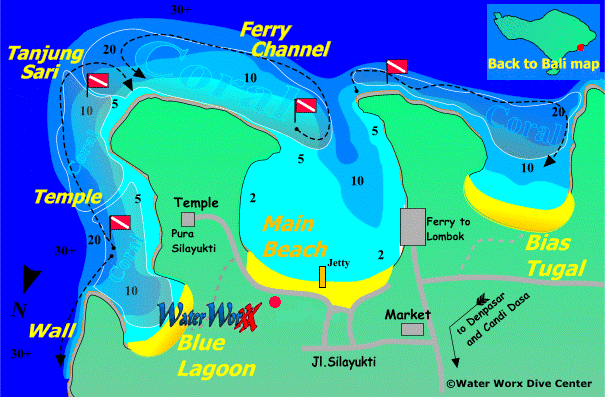
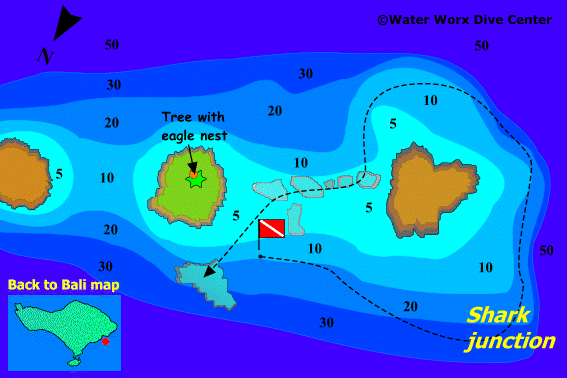
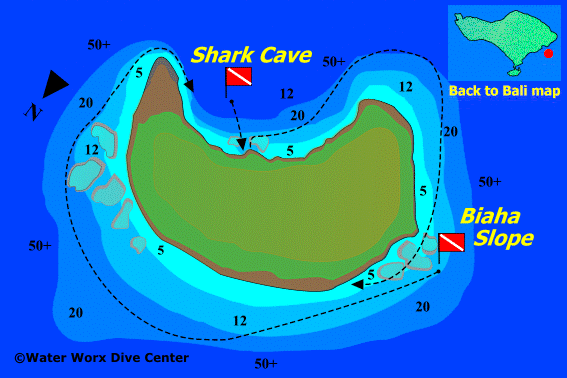
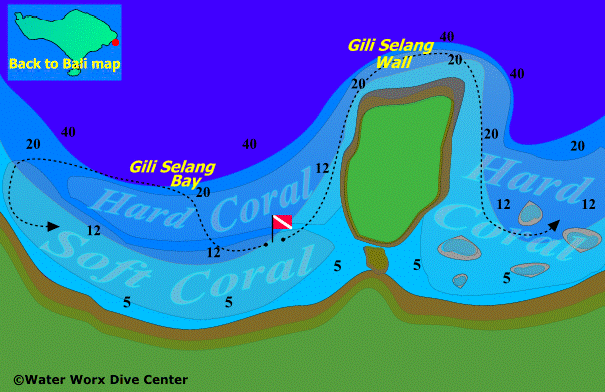
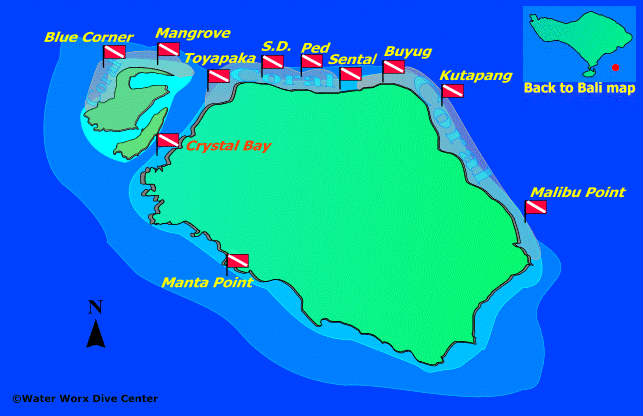
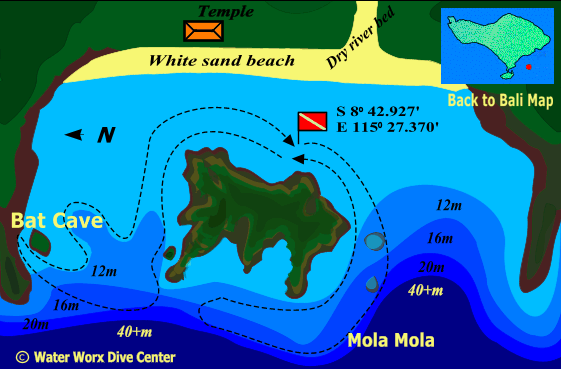
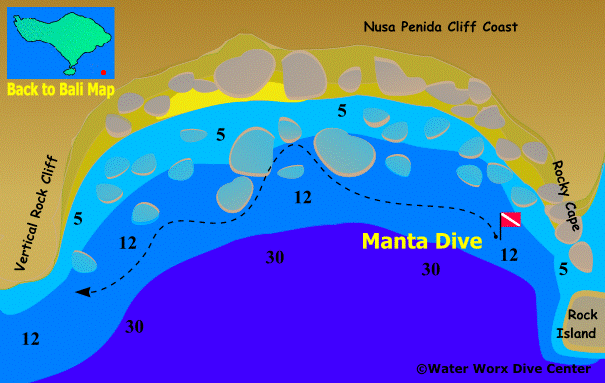
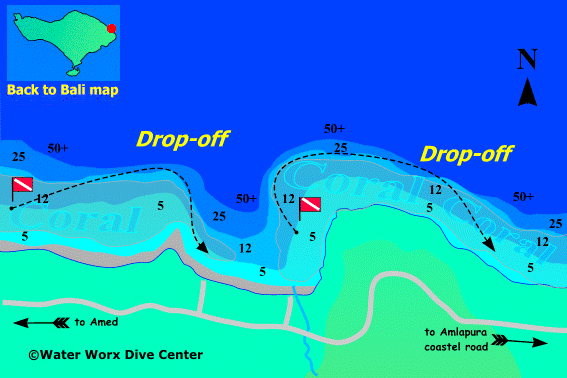
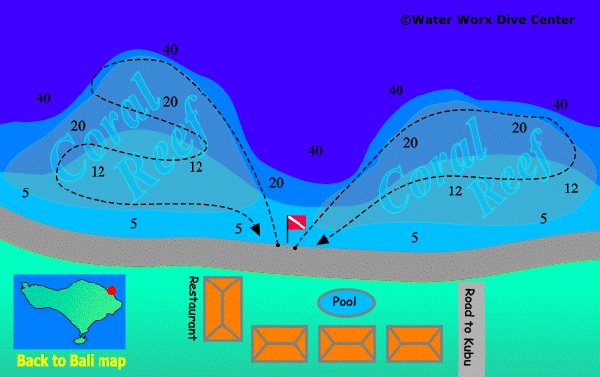
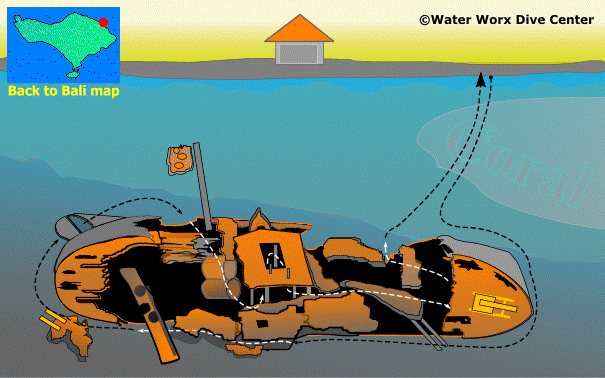
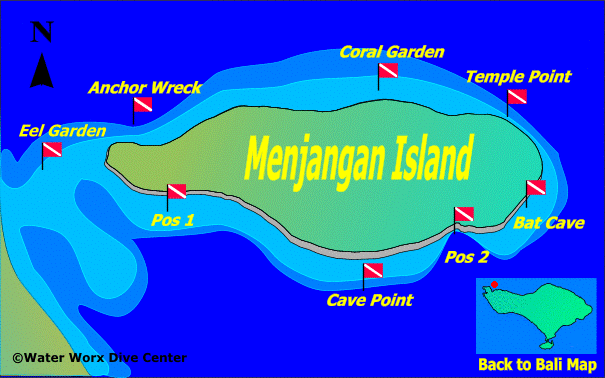
Connect With Us